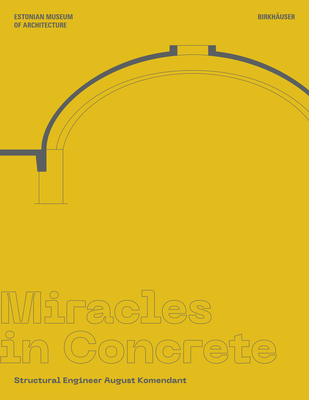Miracles in Concrete: Structural Engineer August Komendant

Miracles in Concrete: Structural Engineer August Komendant
The first comprehensive tribute to Louis Kahn's and Moshe Safdie's structural engineer
The
Estonian-American civil engineer August Komendant (1906-1992) worked
with numerous famous architects and engineers on several of the 20th
century's most iconic buildings.
Concrete was Komendant's
passion through decades. He used his expertise in designing structures
as different as the Kadriorg Stadium grandstand in Tallinn, Estonia
(Elmar Lohk, 1938), the Habitat '67 experimental housing complex in
Montréal, Canada (Moshe Safdie, 1967) and the Kimbell Art Museum in Fort
Worth, Texas, USA (Louis I. Kahn, 1972).
Komendant combined
technical expertise with a keen sense of aesthetics: as an engineer, he
valued the timeless and enduring qualities of architecture. He knew that
miracles require more than spreadsheets and a budget - the creative
impulse is essential.
- One of the most innovative civil engineers of the 20th century.
- Specialized in the use of reinforced concrete and various other concrete technologies
- Structural engineer to architects such as Louis I. Kahn, Moshe Safdie, and Eero Saarinen
Die erste umfassende Würdigung von Louis Kahns und Moshe Safdies Tragwerksplaner
Der estnisch-amerikanische Bauingenieur August Komendant (1906-1992)
arbeitete zusammen mit zahlreichen berühmten Architekten und Ingenieuren
an einigen Ikonen des 20. Jahrhunderts.
Beton war über
Jahrzehnte Komendants Leidenschaft. Er nutzte sein Fachwissen bei so
unterschiedlichen Bauwerken wie der Tribüne des Kadriorg-Stadions in
Tallinn, Estland (Elmar Lohk, 1938), dem experimentellen Wohnkomplex
Habitat '67 in Montréal, Kanada (Moshe Safdie, 1967) und dem Kimbell Art
Museum in Fort Worth, Texas, USA (Louis I. Kahn, 1972).
Komendant verband Sachkenntnis mit einem ausgeprägten Sinn für Ästhetik:
Als Ingenieur schätzte er die zeitlosen und dauerhaften Qualitäten der
Architektur. Er wusste, dass es für Wunder mehr braucht als
Tabellenkalkulationen und ein Budget - der kreative Impuls ist
entscheidend.
- Einer der fortschrittlichsten Bauingenieure des 20. Jahrhunderts
- Zusammenarbeit mit Architekten wie Louis I. Kahn, Eero Saarinen und Mosche Safdie
- Erfinder der Tragwerke für das Salk Institute und Habitat 67
347.14Lei
347.14Lei
Indisponibil
Descrierea produsului
The first comprehensive tribute to Louis Kahn's and Moshe Safdie's structural engineer
The
Estonian-American civil engineer August Komendant (1906-1992) worked
with numerous famous architects and engineers on several of the 20th
century's most iconic buildings.
Concrete was Komendant's
passion through decades. He used his expertise in designing structures
as different as the Kadriorg Stadium grandstand in Tallinn, Estonia
(Elmar Lohk, 1938), the Habitat '67 experimental housing complex in
Montréal, Canada (Moshe Safdie, 1967) and the Kimbell Art Museum in Fort
Worth, Texas, USA (Louis I. Kahn, 1972).
Komendant combined
technical expertise with a keen sense of aesthetics: as an engineer, he
valued the timeless and enduring qualities of architecture. He knew that
miracles require more than spreadsheets and a budget - the creative
impulse is essential.
- One of the most innovative civil engineers of the 20th century.
- Specialized in the use of reinforced concrete and various other concrete technologies
- Structural engineer to architects such as Louis I. Kahn, Moshe Safdie, and Eero Saarinen
Die erste umfassende Würdigung von Louis Kahns und Moshe Safdies Tragwerksplaner
Der estnisch-amerikanische Bauingenieur August Komendant (1906-1992)
arbeitete zusammen mit zahlreichen berühmten Architekten und Ingenieuren
an einigen Ikonen des 20. Jahrhunderts.
Beton war über
Jahrzehnte Komendants Leidenschaft. Er nutzte sein Fachwissen bei so
unterschiedlichen Bauwerken wie der Tribüne des Kadriorg-Stadions in
Tallinn, Estland (Elmar Lohk, 1938), dem experimentellen Wohnkomplex
Habitat '67 in Montréal, Kanada (Moshe Safdie, 1967) und dem Kimbell Art
Museum in Fort Worth, Texas, USA (Louis I. Kahn, 1972).
Komendant verband Sachkenntnis mit einem ausgeprägten Sinn für Ästhetik:
Als Ingenieur schätzte er die zeitlosen und dauerhaften Qualitäten der
Architektur. Er wusste, dass es für Wunder mehr braucht als
Tabellenkalkulationen und ein Budget - der kreative Impuls ist
entscheidend.
- Einer der fortschrittlichsten Bauingenieure des 20. Jahrhunderts
- Zusammenarbeit mit Architekten wie Louis I. Kahn, Eero Saarinen und Mosche Safdie
- Erfinder der Tragwerke für das Salk Institute und Habitat 67
Detaliile produsului










